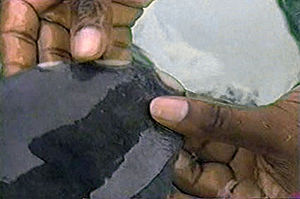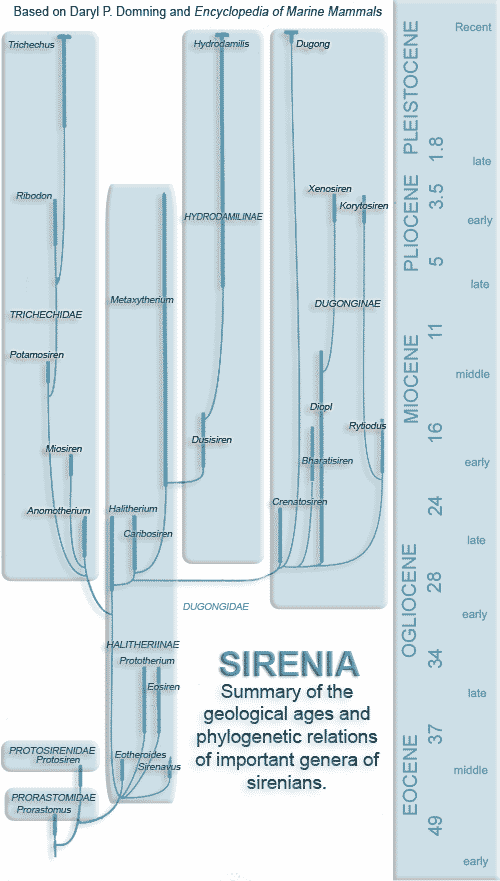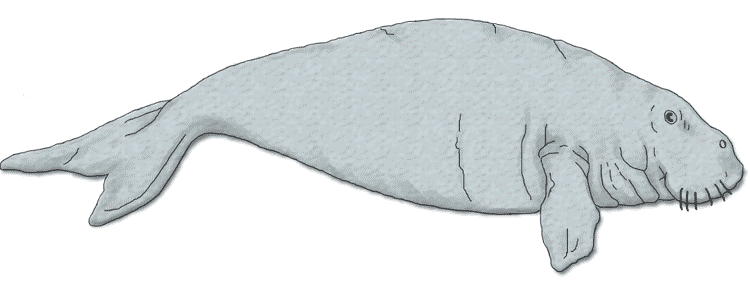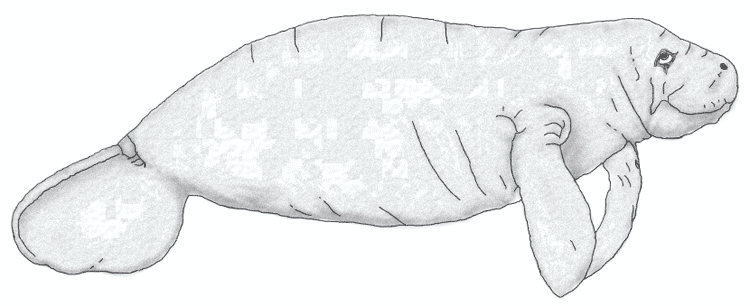
Evolution of sirenians
Encyclopedia

Sirenia
Sirenia is an order of fully aquatic, herbivorous mammals that inhabit swamps, rivers, estuaries, marine wetlands, and coastal marine waters. Four species are living, in two families and genera. These are the dugong and manatees...
is the order
Order (biology)
In scientific classification used in biology, the order is# a taxonomic rank used in the classification of organisms. Other well-known ranks are life, domain, kingdom, phylum, class, family, genus, and species, with order fitting in between class and family...
of placental mammal
Mammal
Mammals are members of a class of air-breathing vertebrate animals characterised by the possession of endothermy, hair, three middle ear bones, and mammary glands functional in mothers with young...
s which comprise modern "sea cows" (manatee
Manatee
Manatees are large, fully aquatic, mostly herbivorous marine mammals sometimes known as sea cows...
s and the Dugong
Dugong
The dugong is a large marine mammal which, together with the manatees, is one of four living species of the order Sirenia. It is the only living representative of the once-diverse family Dugongidae; its closest modern relative, Steller's sea cow , was hunted to extinction in the 18th century...
) and their extinct relatives. They are the only extant herbivorous marine
Marine (ocean)
Marine is an umbrella term. As an adjective it is usually applicable to things relating to the sea or ocean, such as marine biology, marine ecology and marine geology...
mammals and the only group of herbivorous mammals to have become completely aquatic. Sirenians are thought to have a 50-million-year-old fossil
Fossil
Fossils are the preserved remains or traces of animals , plants, and other organisms from the remote past...
record (early Eocene
Eocene
The Eocene Epoch, lasting from about 56 to 34 million years ago , is a major division of the geologic timescale and the second epoch of the Paleogene Period in the Cenozoic Era. The Eocene spans the time from the end of the Palaeocene Epoch to the beginning of the Oligocene Epoch. The start of the...
-recent). They attained modest diversity during the Oligocene
Oligocene
The Oligocene is a geologic epoch of the Paleogene Period and extends from about 34 million to 23 million years before the present . As with other older geologic periods, the rock beds that define the period are well identified but the exact dates of the start and end of the period are slightly...
and Miocene
Miocene
The Miocene is a geological epoch of the Neogene Period and extends from about . The Miocene was named by Sir Charles Lyell. Its name comes from the Greek words and and means "less recent" because it has 18% fewer modern sea invertebrates than the Pliocene. The Miocene follows the Oligocene...
, but have since declined as a result of climatic cooling, oceanographic changes, and human interference. Two genera and four species are extant: Trichechus which includes the three species of manatee that live along the Atlantic
Atlantic Ocean
The Atlantic Ocean is the second-largest of the world's oceanic divisions. With a total area of about , it covers approximately 20% of the Earth's surface and about 26% of its water surface area...
coasts and in rivers and coastlines of the Americas and western Africa
Africa
Africa is the world's second largest and second most populous continent, after Asia. At about 30.2 million km² including adjacent islands, it covers 6% of the Earth's total surface area and 20.4% of the total land area...
, and Dugong
Dugong
The dugong is a large marine mammal which, together with the manatees, is one of four living species of the order Sirenia. It is the only living representative of the once-diverse family Dugongidae; its closest modern relative, Steller's sea cow , was hunted to extinction in the 18th century...
which is found in the Indian
Indian Ocean
The Indian Ocean is the third largest of the world's oceanic divisions, covering approximately 20% of the water on the Earth's surface. It is bounded on the north by the Indian Subcontinent and Arabian Peninsula ; on the west by eastern Africa; on the east by Indochina, the Sunda Islands, and...
and Pacific
Pacific Ocean
The Pacific Ocean is the largest of the Earth's oceanic divisions. It extends from the Arctic in the north to the Southern Ocean in the south, bounded by Asia and Australia in the west, and the Americas in the east.At 165.2 million square kilometres in area, this largest division of the World...
oceans.
Origins






Proboscidea
Proboscidea is a taxonomic order containing one living family, Elephantidae, and several extinct families. This order was first described by J. Illiger in 1881 and encompasses the trunked mammals...
(elephants), group together with the extinct Desmostylia
Desmostylia
Desmostylia is an extinct order of marine mammals which existed from the Arikareean age of the late Oligocene epoch to the Tortonian age of the late Miocene epoch . Their dental and skeletal form suggests desmostylians were amphibious herbivores dependent on littoral habitats...
and likely the extinct Embrithopoda
Embrithopoda
Embrithopoda is an extinct order of mammals which first appeared in the fossil record during the late Eocene and then died out during the Oligocene....
to form the Tethytheria. Tethytheria is thought to have evolved from primitive hoofed mammals ("condylarth
Condylarth
Condylarthra is an order of extinct placental mammals known primarily from the Paleocene and Eocene epochs. Condylarths are among the most characteristic Paleocene mammals and they illustrate the evolutionary level of the Paleocene mammal fauna....
s") along the shores of the ancient Tethys Ocean
Tethys Ocean
The Tethys Ocean was an ocean that existed between the continents of Gondwana and Laurasia during the Mesozoic era before the opening of the Indian Ocean.-Modern theory:...
.
Tethytheria, combined with Hyracoidea (hyraxes) forms a clade
Clade
A clade is a group consisting of a species and all its descendants. In the terms of biological systematics, a clade is a single "branch" on the "tree of life". The idea that such a "natural group" of organisms should be grouped together and given a taxonomic name is central to biological...
called Paenungulata
Paenungulata
Paenungulata is a taxon that groups some remarkable mammals, including three orders that are extant: Proboscidea , Sirenia , and Hyracoidea . At least two more orders are known only as fossils, namely Embrithopoda and Desmostylia...
. Paenungulata and Tethytheria (especially the latter) are among the least controversial mammalian clades, with strong support from morphological and molecular interpretations. The ancestry of Sirenia is remote from that of Cetacea
Cetacea
The order Cetacea includes the marine mammals commonly known as whales, dolphins, and porpoises. Cetus is Latin and is used in biological names to mean "whale"; its original meaning, "large sea animal", was more general. It comes from Ancient Greek , meaning "whale" or "any huge fish or sea...
and Pinnipedia, although they are thought to have evolved an aquatic lifestyle around the same time.
Fossil history

Prorastomus
Prorastomus sirenoides is an extinct species of primitive sirenian that lived during the Eocene Epoch 40 million years ago in Jamaica.-Description:...
, was found in Jamaica, not the Old World
Old World
The Old World consists of those parts of the world known to classical antiquity and the European Middle Ages. It is used in the context of, and contrast with, the "New World" ....
.
The earliest known sea cows, of the families Prorastomidae
Prorastomidae
Prorastomidae is a taxonomic family of extinct animals related to the extant manatees and dugong. The family includes two genera:*Pezosiren*Prorastomus...
and Protosirenidae, are both confined to the Eocene, and were about the size of a pig, four legged amphibious creatures. By the time the Eocene drew to a close, came the appearance of the Dugongidae
Dugongidae
Dugongidae is a family in the order of Sirenia.The family has one surviving species, the Dugong , one recently extinct species, the Steller's Sea Cow , and a number of extinct genera known from the fossil record....
; sirenians had acquired their familiar fully aquatic streamlined body with flipper-like front legs with no hind limbs, powerful tail with horizontal caudal fin, with up and down movements which move them through the water, like cetaceans.
The last of the sirenian families who made their appearance, Trichechidae, apparently arose from early dugongids in the late Eocene or early Oligocene. The current fossil record documents all major stages in hindlimb and pelvic reduction to the extreme reduction in the modern manatee pelvis, providing an example of dramatic morphological change among fossil vertebrates.
Since sirenians first evolved, they have been herbivores, likely depending on seagrass
Seagrass
Seagrasses are flowering plants from one of four plant families , all in the order Alismatales , which grow in marine, fully saline environments.-Ecology:...
es and aquatic angiosperms (flowering plants) for food. To the present, almost all have remained tropical (with the notable exception of Steller's Sea Cow
Steller's Sea Cow
Steller's sea cow was a large herbivorous marine mammal. In historical times, it was the largest member of the order Sirenia, which includes its closest living relative, the dugong , and the manatees...
), marine and angiosperm consumers. Sea cows are shallow divers with large lungs. They have heavy skeletons to help them stay submerged; the bones are pachyostotic (swollen) and osteosclerotic (dense), especially the ribs which are often found as fossils.
Eocene sirenians, like Mesozoic
Mesozoic
The Mesozoic era is an interval of geological time from about 250 million years ago to about 65 million years ago. It is often referred to as the age of reptiles because reptiles, namely dinosaurs, were the dominant terrestrial and marine vertebrates of the time...
mammals but in contrast to other Cenozoic
Cenozoic
The Cenozoic era is the current and most recent of the three Phanerozoic geological eras and covers the period from 65.5 mya to the present. The era began in the wake of the Cretaceous–Tertiary extinction event at the end of the Cretaceous that saw the demise of the last non-avian dinosaurs and...
ones, have five instead of four premolars, giving them a 3.1.5.3 dental formula. Whether this condition is truly a primitive retention in sirenians is still under debate.
Although cheek teeth are relied on for identifying species in other mammals, they do not vary to a significant degree among sirenians in their morphology, but are almost always low-crowned (brachyodont) with two rows of large, rounded cusps (bunobilophodont). The most easily identifiable parts of sirenian skeletons are the skull and mandible, especially the frontal and other skull bones. With the exception of a pair of tusk-like first upper incisors present in most species, front teeth (incisors and canines) are lacking in all, except the earliest sirenians.

